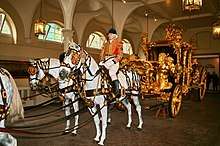Gold State Coach
The Gold State Coach is an enclosed, eight horse-drawn carriage used by the British Royal Family. Commissioned in 1760, it was built in the London workshops of Samuel Butler. It was commissioned for £7,562[1](£1.08 million = US$1.57 million in 2014, adjusted for inflation).
This coach has been used at the coronation of every British monarch since George IV. The coach's great age, weight, and lack of manoeuvrability have limited its use to grand state occasions such as coronations, royal weddings, and the jubilees of a monarch.
The coach is housed at the Royal Mews of Buckingham Palace. It is on view for the public.
Description

The coach weighs four tons and is 24 feet (7.3 m) long and 12 feet (3.7 m) high. It is gilded and features painted panels by Giovanni Battista Cipriani and rich gilded sculpture including three cherubs on the roof (representing England, Ireland and Scotland) and four tritons, one at each corner (representing Britain's imperial power). The body of the coach is slung by braces covered with Morocco leather and decorated with gilt buckles. The interior is lined with velvet and satin. The sculptor Sir Joseph Wilton produced the elaborate carvings on the coach. The roof supports three cherubs representing the union of England, Scotland and Ireland. They carry the Imperial Crown and hold the sword, sceptre and the badge representing Knighthood. The branches of eight gilded palm trees frame the roof. Four corner trees rise from a lion's head and are decorated with symbols of Britain's victory in the Seven Years' War with France. The war was drawing to a close when the coach was built in 1762. Morocco leather straps support the body of the coach and are held by four Triton, mythical sea-gods with a man's head and a dolphin's tail. At the front wheels, the Tritons seem to be using the straps to pull the coach. They are blowing conches, trumpet-like shells to herald the arrival of the Monarch of the Ocean. Gilded dolphins hold in place the bar by which the coach is drawn, and the driver's footboard (no longer used) is in the shape of a scallop shell. The two Tritons at the back carry imperial symbols, representing Britain's maritime traditions and status as a dominate sea power.[2]
The carvings give the Gold Coach the air of a triumphant chariot, reflecting England's powerful position in the world at the time.
The Gold State Coach is pulled by a team of eight horses wearing the Red Morocco harness. Originally driven by a coachman, the eight horses are now postilion-ridden in four pairs.[3] The coach is so heavy it can only be pulled at a walk.[1] The coach has (gilded) brakes, which are operated by the grooms.
As the coach is suspended from braces, it lacks more modern comfort. Modern coaches such as the Australian State Coach and the Diamond Jubilee State Coach have electric windows, heating and hydraulic stabilisers.
In the words of King William IV, a former naval officer, being driven in the Gold State Coach was like being on board a ship "tossing in a rough sea". Queen Victoria complained of the "distressing oscillation" of the cabin. She would often refuse to ride in the Gold State Coach. A later monarch, King George VI said that his journey from the palace to Westminster Abbey for his coronation was "one of the most uncomfortable rides I have ever had in my life".[4] The current monarch, Queen Elizabeth II, referred to her coronation journey in the coach as "horrible" and "not very comfortable".[5]
King George VI had the coach overhauled after the Second World War to rubberise the iron-bound wheels. This would afford at least some comfort to the passengers.[1]
The Gold State Coach has been used since the coronation of Queen Elizabeth II. She used it on the days of her Silver and Golden Jubilees.
The coach is managed by 4 postilions, 9 walking grooms (one of whom walks behind the coach), 6 footmen, and 4 Yeoman of the Guard carrying their long partisans. Eight of the grooms walk beside the horses. The more ornately dressed footmen walk beside the body of the coach. The postilions have to handle the horses when the animals are unruly, and they carry crooked walking-sticks to hold up the traces that may become slack when the coach is taking a corner.[6] The royal coachmen are traditionally clean-shaven. The horses are always Windsor Greys.
See also
References
- 1 2 3 "Gold coach a 'bumpy ride'". BBC News. 4 June 2002. Retrieved 27 May 2016.
- ↑ Mews Catalogue.
- ↑
- ↑ Middleton, Christopher (28 April 2011). "Royal Wedding: will married life get off to a bumpy start in the glass coach?". Telegraph.co.uk. Retrieved 27 May 2016.
- ↑ 'Not very comfortable': Queen remembers her 'horrible' Coronation coach journey
- ↑ Newspaper clipping from 1953 Seen on 1 August 2014.
External links
| Wikimedia Commons has media related to Gold State Coach. |
- "Gold State Coach". Royal Collection Trust. Inventory no. 5000048.
- Description from CNN of the Gold State Coach